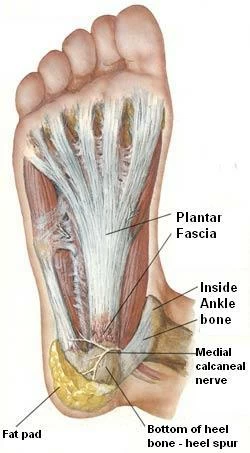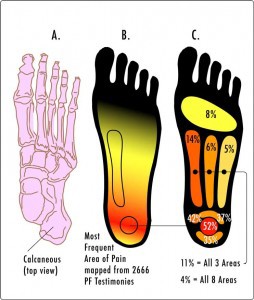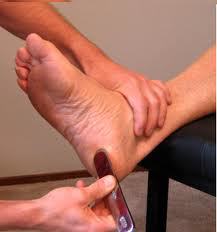After treating hundreds of patients with foot pain I thought it would be important to write a blog post about plantar fasciitis or plantar fascial pain. As Chiropractors, this is by far and away the most common disorder we see when patients present with foot discomfort. Most people don’t realize that Chiropractor’s can offer a non invasive (no drugs or surgery) and effective approach to treating plantar fasciitis. Chiropractic care is not just limited to the spine, but a lot of Chiropractors have continued their educations to become some of the leading manual and extremity specialists in the world. Lets first talk about what plantar fasciitis is to give a better understanding of the condition and its treatment.
The plantar fascia is piece of connective tissue that attaches to the medial calcaneal tubercle (the inside bottom of your heel bone) and inserts onto the proximal phalanges (toes). It is not elastic, like muscle, but is rather fibrotic. Its function is to hold up the arches of the foot (yes, you have more than one…in fact, there are three). For the function of this discussion, we’ll be discussing the medial longitudinal arch. There are two muscles that run deep to the plantar fascia, the Flexor Digitorum Brevis and the Quadratus Plantae. There are also numerous muscles that run from your leg (tibia and fibula) and connect to the bottom of the foot. These muscles contribute greatly to the ‘sling’ that holds the arches together…usually, these are forgotten when it comes to rehabilitating a foot injury!
Plantar fascitis in a painful condition and the pain is usually felt the most when going from a period of rest to activity. For example, a common complaint in our chiropractic office from someone with plantar fasciitis is that the pain is worst when they first get out of bed in the morning. This makes sense as the foot has been resting all night…you then put the foot on the ground, it pronates quickly to adapt to the floor surface (thereby stretching the damaged plantar fascia)…

and this creates pain. As the condition gets worse, more and more activities become restricted. Generally, the pain will continue to build until the person is frustrated enough to seek care. Some people say that the condition will resolve on its own in about 18 months but there are no reliable sources that validate this. I think this is more of what you hear from frustrated practitioners who can’t fix the problem!

The common approach to plantar fascial pain is to stretch, stretch, and stretch the fascia. This makes little sense to me. If you had a broken bone, would you stretch it apart to have it heal? If you ripped a muscle, would you stretch it to get it to heal? The answer to these questions is a resounding ‘NO’. The approach to the plantar fascia is no different. You don’t have a plantar fascial injury due to a lack of stretching, you have it because of too much stretching. The plantar fascia stretches with pronation, so too much pronation will lead to a stretched and damaged plantar fascia. Unfortunately, many people over pronate (or have pes planus…a collapsed arch) and this can lead to their problem. Even if a person is pes cavus (this means they have a high arch), they can develop plantar fascitis. This is usually due to running or other activity. Basically, as long as the arch is being pounded on, regardless your arch size, you can develop plantar fascial pain.
Many therapists propose stretching the plantar fascia along with the Achilles tendon. There is no direct connection between the plantar fascia and the Achilles, although there are some fascial connections. Being the Achilles (made up of the Soleus and Gastrocnemius muscles) does tend to be facilitated, it makes sense to stretch this region and work the anterior muscles so through reciprocol inhibition, you can reflexively shut off the ‘Gastroc-soleus’ Complex. However in my 5 years of Chiropractic care in Naperville I have rarely seen stretching the Achilles tendon to be an effective form of treatment.
In regards to other therapeutic approaches, be they ultrasound, shock-wave therapy, cortisone, laser, electrical stimulation, etc…nothing is really a clear choice in the literature. This is evident clinically as most of the people I treat for this condition come to me after trying every other gizmo and gadget out there. Most of the time, they simply don’t work. I won’t go as far as to say that the above-listed interventions are a waste, but again, they do not generally ‘cure’ the problem for most people. Think about it this way…unless something is done to re-establish the arch itself, it’s unlikely anything is going to fully work. This should make sense. Now let us discuss the chiropractic approach

Many chiropractors and podiatrists make orthotics for their plantar fascitis patients. This is great, provided they are made properly. A rigid orthotic is a poor choice for an athlete as running on hard fiberglass while already having a foot problem rarely helps. I’ve taken hundreds of patients out of rigid orthotics and put them in semi-rigid products. Bottom line: they work better…your foot isn’t a rigid object anyway. It’s meant to move, but it does need to be supported. In regards to functional vs. accommodative orthotics, I won’t get any more into that now more than to say that I prefer to make functional orthotics. I also now use a cheaper product that involves a dynamic fitting, should money be an issue. As a Chiropractor have found that they both work very well, provided the patient is already on the road to recovery for the condition.

So, what is the ‘new take’ on treatment for plantar fascitis? It’s actually rather simple. Find a chiropractic practitioner who is licensed in Active Release Techniques (ART) and Graston Technique. These techniques provide excellent treatment approaches for the soft tissue compromise/scar tissue that is residing in the area when you have plantar fascists. Chiropractic manipulation of the joints of the foot is vital as fixated joints will certainly put stress on the local soft tissues. Simply put, you have to clean out the area before proper healing can occur. Taping the arch with Kinesio Tape is a great way to support the structures. It is a slam dunk case when the arch is taped and the pain goes away. If the tape doesn’t work, there might be other underlying issues, such as traction spurs or stress reactions in some of the bones of the foot.
If you are interested in making an appointment with a Naperville Chiropractor due to your foot pain CLICK HERE for a comprehensive chiropractic exam and consultation to determine whether or not we can help you.







